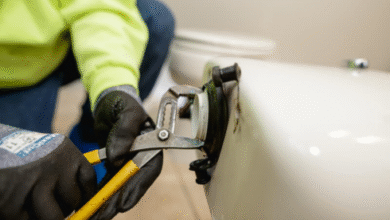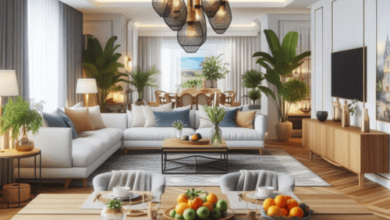With the increasing need for a secure and comfortable living space, selecting the right building materials and implementing safety measures are paramount for homeowners aiming to create a smart, safe, and welcoming environment. It is crucial to be informed about the construction materials that best suit your home, as well as to understand the importance of security measures, including camera systems. This blog post aims to guide homeowners through essential considerations when building or renovating, from materials to safety strategies.
The Importance of Smart Building Decisions
Every homeowner dreams of creating the perfect living space. Achieving this often hinges on smart building decisions. Selecting the right materials, ensuring compliance with safety standards, and choosing modern security options all play significant roles in this endeavor. Homebuilding or renovation requires more than aesthetic appeal; it demands durability, environmental consciousness, and a strong commitment to safety.
Modern materials provide longevity and eco-friendly benefits, crucial as environmental awareness increases. MBuilders, for example, incorporates these materials to enhance both durability and sustainability in their projects. Alongside, advanced security measures like cutting-edge camera systems ensure a safe living environment. By understanding these options, you can create a cohesive, secure, and comfortable home that addresses both safety and sustainability.
Understanding Building Materials
Choosing building materials involves considering several factors that affect the final build. This includes durability, cost, and sustainability. The right materials contribute to a building’s robustness, aesthetic appeal, and environmental impact.
Durability is paramount, ensuring the longevity of structures. This involves not only initial cost but also long-term maintenance. Sustainable materials lessen the environmental footprint and may provide energy efficiency benefits, offering an attractive option for eco-conscious homeowners focusing on both aesthetics and sustainability.
Exploring Material Types
A wide range of materials is available to suit various architectural needs. Wood, known for its versatility and sustainability, remains popular but requires protection from weather elements and pests. Concrete offers strength and durability but has a significant manufacturing carbon footprint. Glass provides aesthetic appeal and energy efficiency but requires careful handling and installation. Stone, valued for its natural beauty and durability, can be heavier and pricier than alternatives. Each material offers distinct benefits and challenges to consider during selection based on durability, environmental impact, and personal preference.
Making Sustainable Choices
With an emphasis on sustainability, building materials should reflect current environmental standards. Look for materials with recycled content or reduced manufacturing impact. Bamboo and cork are excellent alternatives to traditional materials due to their rapid growth and minimal environmental impact. Recycled steel or reclaimed lumber offer similar benefits, aligning aesthetics with environmental responsibility. The environmental footprint of materials is reshaping modern architecture, offering both aesthetic and sustainability benefits.
Prioritizing Safety in Construction
Safety during construction is key to protecting builders and future occupants. This includes not only the construction itself but also adhering to building codes and safety regulations that aid in structural integrity and occupant safety. Selecting materials that are fire-resistant and non-toxic supports a healthier living environment, while understanding building codes ensures these standards are met.
Fire Safety Considerations
Fire-resistant materials significantly impact home safety. Using retardant-treated wood, fireproof insulation, or non-combustible roofing reduces fire risk. Fire-resistant gypsum board is a crucial interior material for fire safety, resisting fire spread for extended periods. Understanding these options can drastically improve a home’s safety, providing peace of mind in the home environment.
Non-toxic Materials for Healthier Living
The choice of non-toxic materials impacts indoor air quality and long-term health. Traditional paints and adhesives often release harmful volatile organic compounds (VOCs). Today, low-VOC or zero-VOC options provide healthier alternatives without aesthetic compromise. Similarly, formaldehyde-free insulation improves air quality, promoting a healthier living space.
Ensuring Structural Integrity
Beyond material selection, structural integrity relies on skilled workmanship and strict adherence to construction standards. Detailed inspections and employing certified professionals ensure compliance with building codes, underpinning structural safety. Adopting innovative design practices also enhances structural resilience.
Incorporating Modern Security Features
Home safety extends to modern security features, starting with camera systems that provide constant monitoring and peace of mind. Advanced systems allow remote monitoring, integrating with other smart home features. Understanding security options ensures your home remains secure, complementing architectural advancements.
Understanding Home Camera Systems
Camera systems are vital for security, offering features like HD recording, night vision, and motion detection accessible on multiple devices. These systems deter intruders and provide important evidence when needed. An example of a company providing top-notch security technology is Coastal Burglar Alarm, known for its innovative solutions. Understanding these features helps in making informed decisions to boost home security.
Choosing the Right Security System
When selecting a camera system, consider factors like coverage areas, installation ease, and connectivity options. Wireless systems often provide simpler installations, while hardwired systems offer reliability. Assessing your home’s specific needs informs system choice, ensuring the right balance of coverage and convenience.
Integrating Security for Smart Homes
Security systems now integrate seamlessly with other smart home technologies. These integrations provide enhanced functionality, from controlling cameras via voice commands to setting automated alerts through smart assistants. Recognizing security components’ compatibility enhances home safety and showcases technology’s role in smart living.
Creating a Comprehensive Safety Plan
Security extends beyond equipment to comprehensive safety planning. Regular maintenance, frequent security updates, and emergency response plans ensure robust security measures. Establishing clear safety procedures and regular audits maintains enhanced security, offering homeowners peace of mind delivered through informed planning.
Bringing It All Together
Building a smart and safe home requires thoughtful material choices and security measures. The decisions made today, from materials to features, shape your home’s security and environmental impact. By considering various options and future-proofing designs, homeowners can achieve their goals without compromising safety or sustainability.
Home rehabilitation or development is about more than appearances; it’s an investment in a safe and resilient future. Thorough research and expert consultations make this future possible. Enhance your home’s safety, aesthetic appeal, and durability while contributing to a sustainable future. Pursue safety and sustainability, and consider consulting experts to ensure dream homes align with both present and future needs.





